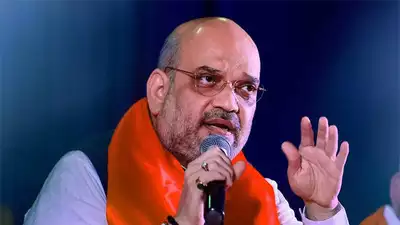Within days of China’s cartographic invasion of Arunachal Pradesh, Home Minister Amit Shah mounted India’s riposte by visiting a border village next to the Line of Actual Control (LAC).
Shah visited Kibithoo days after China had renamed 11 locations in Arunachal, implying that Beijing did not recognise India’s sovereignty in the sensitive border state.
China poked India in the eye ahead of the Shanghai Cooperation Organisation (SCO) summit in the Indian capital in July. By doing so Beijing ruled out the possibility of any thaw in the India-China relationship during President Xi Jinping’s expected visit to New Delhi.
Ties between India and China plummeted since May 2020 after People’s Liberation Army (PLA) troops crossed the Line of Actual Control (LAC) in several locations in Eastern Ladakh, changing the status quo.
As expected, China has objected to Shah’s visit. Chinese foreign ministry spokesperson, Wang Wenbin pointed out on Monday that “Zangnan (South Tibet in Chinese) is China’s territory”.
“The Indian official’s visit to Zangnan violates China’s territorial sovereignty, and is not conducive to the peace and tranquillity of the border situation,” Wang said. China calls Arunachal Pradesh as South Tibet and has staked territorial claims on it.
By mounting a cartographic invasion in Arunachal and reinforcing its anti-India line on Monday, China has once again miscalculated India’s resolve to reject and counter any Chinese encroachments in the prized border state.
Unsurprisingly, Shah has resolutely conveyed to China that New Delhi will proactively develop and defend Arunachal right from the frontline border villages in the state.
Kibithoo is a symbol of PM Narendra Modi’s ‘Vibrant Villages Programme’ (VVP)—an initiative to build a swathe of fully developed villages along the LAC, reinforcing India’s political will to defend and develop its borders. Under the VVP scheme, which will focus on road connectivity, 2,967 villages in 46 blocks of 19 districts abutting the northern border in the states of Arunachal Pradesh, Sikkim, Uttarakhand and Himachal Pradesh and the Union Territory of Ladakh will be comprehensively developed.
In the first phase, Arunachal, which was a major theatre of the 1962 war, will be the prime focus. Of the 662 villages identified for priority coverage, 455 are in Arunachal Pradesh.
The VVP is part of a much bigger enterprise of imparting rail and road connectivity to the Himalayan frontiers with China in the east.
The proposed rail network will also have a spur heading into Bhutan, which came into prominence in 2017, during the standoff with China in Doklam. Doklam is on the trijunction of India, Bhutan and China. Chinese presence in the area can threaten the Siliguri corridor—the narrow “chicken’s neck” that connects the northeast with the rest of India.
During the visit earlier this month to India by Bhutanese King Jigme Khesar Namgyel Wangchuk, a decision was taken to build the Kokrajhar to Gelephu rail link—the first between India and Bhutan.
India is planning to provide rail connectivity to Bhutan. The first-ever broad gauge line will come up from Kokrajhar in India to Gelephu in Bhutan at an estimated cost of Rs 1,000 crore.
The 57.5 km-long Kokrajhar-Gelephu rail link is expected to serve the long need for rail pic.twitter.com/MAzCb8R6HN
— Aadhavan S (@s_aadhavan) June 7, 2022
The decision to speed up the construction of the 57.7 rail link, may not be the best option from a strategic perspective but is nevertheless important. Ideally, it would have been best to connect Mujnai in West Bengal with Neyopaling in Bhutan’s Samstse district, which is closer to the tri-junction. But the 37.5 km-long rail route, which would pass through tea gardens, hit a roadblock due to problems with land acquisition.
In the drive for connectivity, India’s focus is majorly on Arunachal, as signalled by the Home Minister’s visit. More precisely, the government is concentrating on fortifying Tawang and Aalo by connecting these frontline positions with the hinterland.
The Chinese have been eyeing Tawang as its famous monastery is Asia’s largest. Besides, the sixth Dalai Lama was born in Tawing, making the spiritual lineage the basis for China’s territorial claims.
India sees urgency in improving connectivity as Bumla, a border pass is just 37 kilometres from Tawang.
Imparting protection to Aalo is also important, as it is the gateway to Mechuka Valley, which is just 29 kilometres from the China border.
India is also keen to take the railway toward Nathu La as it is not far from Yadong—a town in the Chumbi valley less than 50 kilometres away.
The Chinese are currently busy in extending their Tibetan railway to Yadong, threatening Nathu La. Besides, the Chinese have already operationalised the Lhasa–Nyingchi railway. Trains travelling at a speed of around 160 kilometres an hour can travel along the 435.48-kilometre track. Nyngchi is located bang opposite Arunachal Pradesh and is not far from the great bend of the Brahmaputra before the mighty river enters India.
In response to the Chinese provocations, India is giving a befitting response by building the 378-km-long Bhalukpong-Tenga-Tawang railway. The track will pass through difficult terrain, including the 13000 feet Sela pass.
Discussed the progress of Bhalukpong-Tenga-Tawang, North Lakhimpur-Bame-Aalo-Silapathar and Pasighat-Tezu-Parasuram Kund-Rupai rail projects with Shri Anshul Gupta Ji, GM, @RailNf and other railway officials present. 1/2@RailMinIndia pic.twitter.com/Nm6heCsW90
— Pema Khandu པདྨ་མཁའ་འགྲོ་། (@PemaKhanduBJP) December 9, 2022
Around 80 per cent of the track will pass through tunnels. Besides, the defence of Tawang is also being reinforced by the Border Roads Organisation (BRO), which is currently building a 3,000 metres Sela tunnel, enabling all-weather connectivity with Guwahati in Assam.
Arunachal Pradesh | The Sela Tunnel project, bi-lane road tunnel at an altitude above 13,000 feet upon completion. It is being excavated below 4,200 meters of Sela Pass and promises to provide all-weather connectivity to Tawang, pic.twitter.com/2vVopcnzAq
— ANI (@ANI) October 21, 2021
In addition, the 247.85-km-long North Lakhimpur- Bame-Aalo-Silapathar rail route is almost complete, and decks are being cleared for the Rangpo-Gangtok-Nathu La railway project, offsetting Chinese forays in Yadong.




















